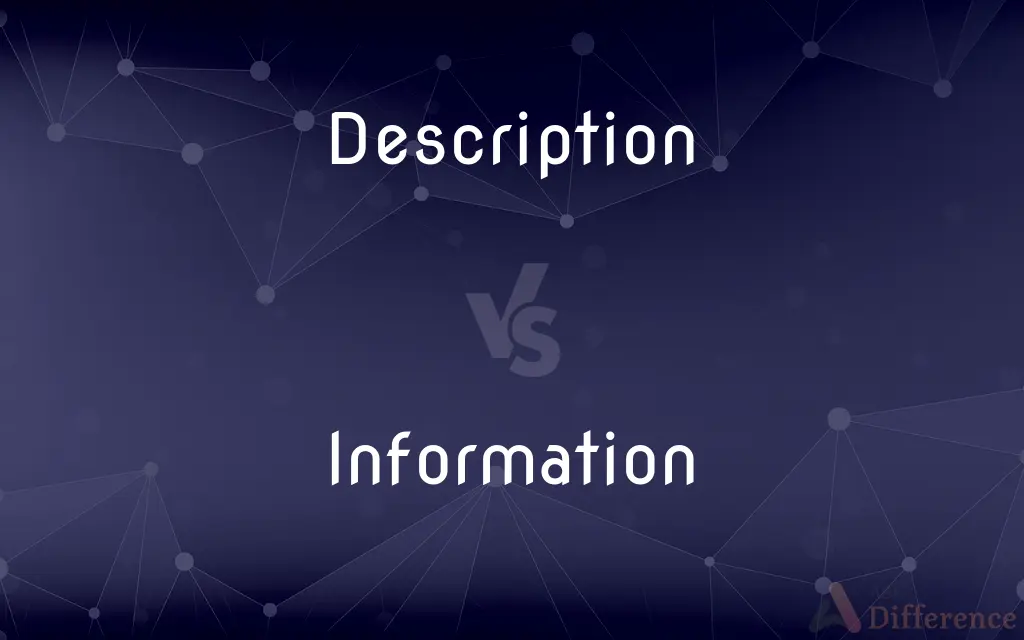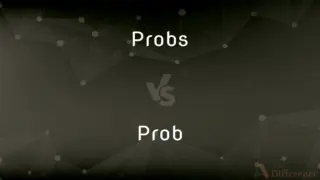Description vs. Information — What's the Difference?
By Tayyaba Rehman & Maham Liaqat — Updated on April 6, 2024
Description focuses on detailing characteristics or features, while information provides facts or data.

Difference Between Description and Information
Table of Contents
ADVERTISEMENT
Key Differences
Description is the act of portraying or depicting something in words, emphasizing visual imagery, sensations, or characteristics to convey a vivid picture. It aims to give the reader or listener a detailed understanding of an object, person, scene, or event. Information, on the other hand, is concerned with providing facts, data, or knowledge about a subject, focusing on delivering content that is useful for understanding, decision-making, or learning, without necessarily painting a vivid picture.
While description might use adjectives and imagery to create a mental image or evoke feelings, information prioritizes accuracy, relevance, and utility, often presented in a straightforward, factual manner. This distinction underscores description’s role in enhancing experiential understanding and information’s role in increasing cognitive knowledge.
Description can be subjective, influenced by the describer's perception, experience, and choice of language, aiming to engage the senses and emotions. Information strives for objectivity, presenting facts and data that are verifiable and independent of personal feelings or biases, aiming to inform or educate rather than evoke sensory or emotional responses.
In literature, for example, description plays a key role in setting scenes and developing characters, using detailed language to bring stories to life. In contrast, informational texts, such as textbooks or reports, use precise and clear language to convey facts and concepts, prioritizing clarity over imaginative engagement.
Understanding the difference between description and information is crucial in communication, as it affects how messages are crafted and received. Description is chosen to create a mood, build a scene, or detail characteristics, while information is used when the goal is to educate, inform, or provide a basis for decision-making.
ADVERTISEMENT
Comparison Chart
Focus
Portraying characteristics or features in detail.
Providing facts, data, or knowledge.
Purpose
To evoke imagery, feelings, or a vivid understanding.
To inform, educate, or aid in decision-making.
Nature
Subjective, relying on the observer’s perception and language.
Objective, presenting verifiable facts and data.
Language
Uses adjectives, metaphors, and sensory details.
Prioritizes accuracy, clarity, and relevance.
Role in Communication
Enhances experiential understanding and engagement.
Increases cognitive knowledge and understanding.
Compare with Definitions
Description
The process of detailing aspects or traits to create a vivid image.
The artist’s description of her painting process intrigued the audience.
Information
Facts or data provided or learned about something or someone.
The information in the report was crucial for making the decision.
Description
A narrative or account that provides visual or experiential details.
The travel brochure’s description of the beach resort was captivating.
Information
Details or data about a subject that inform or enlighten.
The seminar provided essential information on the new regulations.
Description
Depiction or portrayal that evokes sensory or emotional responses.
The description of the meal was so enticing, it made everyone hungry.
Information
Knowledge acquired through study, experience, or instruction.
She gathered a lot of information on the topic through her research.
Description
The act of depicting or portraying something in words, focusing on characteristics or features.
The book’s description of the ancient city made readers feel as if they were walking its streets.
Information
Data or facts that are made available or accessible.
The library is a valuable resource for finding information on any subject.
Description
A detailed account or explanation of an object, person, or scene.
His description of the event was so vivid, it was like witnessing it firsthand.
Information
The communication or reception of knowledge or intelligence.
The internet has significantly facilitated the dissemination of information.
Description
Description is the pattern of narrative development that aims to make vivid a place, object, character, or group. Description is one of four rhetorical modes (also known as modes of discourse), along with exposition, argumentation, and narration.
Information
Information can be thought of as the resolution of uncertainty; it answers the question of "What an entity is" and thus defines both its essence and the nature of its characteristics. The concept of information has different meanings in different contexts.
Description
A spoken or written account of a person, object, or event
People who had seen him were able to give a description
Information
Knowledge or facts learned, especially about a certain subject or event.
Description
A type or class of people or things
It is laughably easy to buy drugs of all descriptions
Information
The act of informing or the condition of being informed; communication of knowledge
Safety instructions are provided for the information of our passengers.
Description
The act, process, or technique of describing.
Information
(Computers) Processed, stored, or transmitted data.
Description
A statement or an account describing something
Published a description of the journey.
Gave a vivid description of the game.
Information
A numerical measure of the uncertainty of an experimental outcome.
Description
A pictorial representation
Monet's ethereal descriptions of haystacks and water lilies.
Information
(Law) A formal accusation of a crime made by a public officer rather than by grand jury indictment in instances in which the offense, if a federal crime, is not a felony or in which the offense, if a state crime, is allowed prosecution in that manner rather than by indictment.
Description
A kind or sort
Cars of every size and description.
Information
That which resolves uncertainty; anything that answers the question of "what a given entity is".
Description
A sketch or account of anything in words; a portraiture or representation in language; an enumeration of the essential qualities of a thing or species.
Give a verbal description of the events
A realistic description
Information
Things that are or can be known about a given topic; communicable knowledge of something.
I need some more information about this issue.
Description
The act of describing; a delineation by marks or signs.
Information
The act of informing or imparting knowledge; notification.
For your information, I did this because I wanted to.
Description
A set of characteristics by which someone or something can be recognized.
The zoo had no lions, tigers, or cats of any description.
Information
A statement of criminal activity brought before a judge or magistrate; in the UK, used to inform a magistrate of an offence and request a warrant; in the US, an accusation brought before a judge without a grand jury indictment.
Description
(taxonomy) A scientific documentation of a taxon for the purpose of introducing it to science.
The type description of the fungus was written by a botanist.
Information
(obsolete) The act of informing against someone, passing on incriminating knowledge; accusation.
Description
(linguistics) The act or practice of recording and describing actual language usage in a given speech community, as opposed to prescription, i.e. laying down norms of language usage.
Information
The systematic imparting of knowledge; education, training.
Description
(linguistics) A descriptive linguistic survey.
Information
The creation of form; the imparting of a given quality or characteristic; forming, animation.
Description
The act of describing; a delineation by marks or signs.
Information
[…] the meaning that a human assigns to data by means of the known conventions used in its representation.
Description
A sketch or account of anything in words; a portraiture or representation in language; an enumeration of the essential qualities of a thing or species.
Milton has descriptions of morning.
Information
(Christianity) Divine inspiration.
Description
A class to which a certain representation is applicable; kind; sort.
A difference . . . between them and another description of public creditors.
The plates were all of the meanest description.
Information
A service provided by telephone which provides listed telephone numbers of a subscriber.
Description
A statement that represents something in words
Information
(information theory) Any unambiguous abstract data, the smallest possible unit being the bit.
Description
The act of describing something
Information
As contrasted with data, information is processed to extract relevant data.
Description
Sort or variety;
Every description of book was there
Information
(information technology) Any ordered sequence of symbols (or signals) (that could contain a message).
Information
The act of informing, or communicating knowledge or intelligence.
The active informations of the intellect.
Information
Any fact or set of facts, knowledge, news, or advice, whether communicated by others or obtained by personal study and investigation; any datum that reduces uncertainty about the state of any part of the world; intelligence; knowledge derived from reading, observation, or instruction.
Larger opportunities of information.
He should get some information in the subject he intends to handle.
Information
A proceeding in the nature of a prosecution for some offense against the government, instituted and prosecuted, really or nominally, by some authorized public officer on behalf of the government. It differs from an indictment in criminal cases chiefly in not being based on the finding of a grand jury. See Indictment.
Information
A measure of the number of possible choices of messages contained in a symbol, signal, transmitted message, or other information-bearing object; it is usually quantified as the negative logarithm of the number of allowed symbols that could be contained in the message; for logarithms to the base 2, the measure corresponds to the unit of information, the hartley, which is log210, or 3.323 bits; called also information content. The smallest unit of information that can be contained or transmitted is the bit, corresponding to a yes-or-no decision.
Information
Useful facts, as contrasted with raw data; as, among all this data, there must be some interesting information.
Information
A message received and understood
Information
A collection of facts from which conclusions may be drawn;
Statistical data
Information
Knowledge acquired through study or experience or instruction
Information
(communication theory) a numerical measure of the uncertainty of an outcome;
The signal contained thousands of bits of information
Information
Formal accusation of a crime
Common Curiosities
Can description include information?
Yes, descriptions can include factual information as part of detailing characteristics or features.
Why is information important in decision-making?
Information provides the factual basis needed to make informed decisions, reducing uncertainty.
What role does information play in education?
Information is central to education, providing the knowledge base for learning, understanding concepts, and developing skills.
How does description affect reader engagement?
Description can significantly enhance reader engagement by creating vivid images and evoking emotions.
Is information always objective?
Ideally, information should be objective, but the selection and presentation of facts can introduce bias.
Can information be descriptive?
Information can be presented in a descriptive way to clarify or emphasize facts, but its primary aim remains to inform.
Can too much description detract from clarity?
Yes, overly detailed descriptions can overwhelm the reader and detract from the clarity or pace of the narrative.
How do you balance description and information in writing?
Balancing description and information involves considering the purpose and audience of the writing, ensuring the right mix to achieve the desired effect or convey the necessary knowledge.
How do descriptions contribute to storytelling?
Descriptions contribute to storytelling by setting scenes, developing characters, and evoking a sense of place and mood.
Can the way information is presented affect its perception?
Yes, the presentation of information can influence how it's perceived and understood, emphasizing the importance of clarity and context.
Is descriptive writing less valuable than informational writing?
No, both have their value, depending on the purpose of the writing. Description enhances experiential understanding, while information increases cognitive knowledge.
What makes information reliable?
Reliable information is accurate, verifiable, and comes from credible sources, free from bias or distortion.
How do you verify the accuracy of information?
Verifying the accuracy of information involves checking multiple, credible sources, considering the evidence, and assessing the reliability of the source.
How does digital media influence the availability of information?
Digital media has greatly increased the availability of information, making it more accessible but also raising challenges regarding quality and reliability.
What makes a good description?
A good description vividly portrays its subject in a way that engages the senses and emotions, making the reader or listener feel present or connected.
Share Your Discovery

Previous Comparison
Probs vs. Prob
Next Comparison
Dickly vs. DicktyAuthor Spotlight
Written by
Tayyaba RehmanTayyaba Rehman is a distinguished writer, currently serving as a primary contributor to askdifference.com. As a researcher in semantics and etymology, Tayyaba's passion for the complexity of languages and their distinctions has found a perfect home on the platform. Tayyaba delves into the intricacies of language, distinguishing between commonly confused words and phrases, thereby providing clarity for readers worldwide.
Co-written by
Maham Liaqat













































